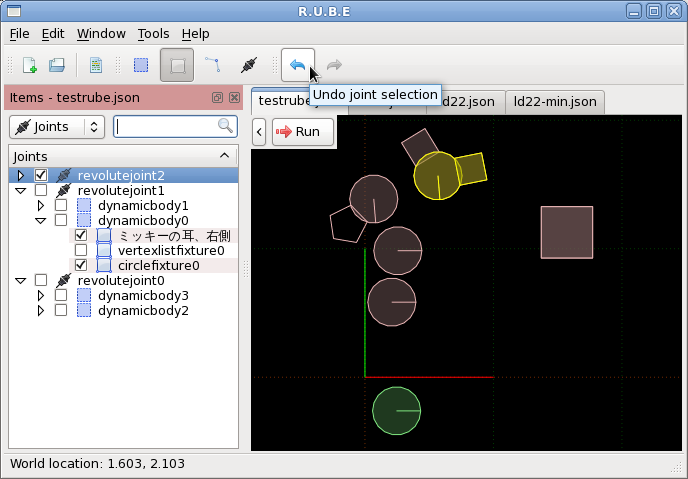R.u.b.e Box2d Editor

Nov 24, 2012 The R.U.B.E Box2D editor exports plain-text JSON which can be loaded into other physics engines that have similar representations of bodies, shapes, etc. Here is a partial implementation of a. I am really interested in using the R.U.B.E editor to create my own players and what not. I am getting accustomed to Box2D through the use of LibGDX. But i can not find any resources (tutorials or examples) on how to load the JSON file into the Box2D world and use it. Please point me into some direction!
| Developer(s) | Erin Catto |
|---|---|
| Initial release | September 11, 2007 |
| Stable release | |
| Repository | |
| Written in | C++ |
| Operating system | OS independent |
| Type | Middleware |
| License | zlib[2] |
| Website | www.box2d.org |
Box2D is a freeopen source2-dimensionalphysics simulatorengine written in C++ by Erin Catto and published under the zlib license. It has been used in Crayon Physics Deluxe, Limbo, Rolando, Incredibots, Angry Birds, Tiny Wings, Shovel Knight, Transformice, Happy Wheels,[3] and many online Flash games,[4] as well as iPhone, iPad and Android games using the Cocos2d or Moscrif game engine and Corona framework.
History[edit]
Box2D was first released as 'Box2D Lite', a demonstration engine to accompany a physics presentation given by Erin Catto at GDC 2006. On September 11, 2007 it was released as open source on Sourceforge. On January 17, 2010 Box 2D moved the project to Google Code for hosting.[5] On July 12, 2015 hosting was moved again, this time to GitHub[6].
You can change the value of each data inside test.data file. Microprocessor design using verilog hdl ebook login. `define rowd 8 // The number of data in data memory. Do not change this number. We only use 8 data. Total number is fixed at 8.
Battle vs chess serial key codes. On March 6, 2008, version 2.0 was launched, introducing continuous collision detection and revamping the API.
Cross-platform availability[edit]
Box2D is itself written in platform-independent C++ (usable on any system with a C++ compiler available). The engine may be compiled in fixed point and floating point modes, and has been used on the Nintendo DS, Wii, and several mobile phones (including Android, BlackBerry 10 and iOS) as well as most major operating systems.
The engine has been ported to many other programming languages and environments, including Java,[7]Adobe Flash (in ActionScript[8] and Haxe[9] languages), C#,[10]Lua, JavaScript,[11][12] and D.[13]Bindings exist to use the compiled library from Python[14], DarkBASIC and BBC_BASIC.
On October 30, 2009, it was announced that Box2D was being integrated into the (now older) Torque 2D game engine.[15]
Programs that use the engine[edit]
- GameMaker: Studio, uses the engine for physics simulation.
- LibGDX, uses the physics engine for games and Lighting.
- Stencyl, uses the physics engine for games, and allows export to Flash and iOS.
- Isogenic Engine
- LÖVE, uses the physics engine for games[16]
- Clickteam Fusion[citation needed]
- Defold, released by King in 2016
Features[edit]
Box2D performs constrained rigid body simulation. It can simulate bodies composed of convex polygons, circles, and edge shapes. Bodies are joined together with joints and acted upon by forces. The engine also applies gravity, friction, and restitution.
Box2D's collision detection and resolution system consists of three pieces: an incremental sweep and prunebroadphase, a continuous collision detection unit, and a stable linear-time contact solver. These algorithms allow efficient simulations of fast bodies and large stacks without missing collisions or causing instabilities.[17]

Related engines[edit]
An earlier version of the Box2D engine, now known as Box2D Lite, was released primarily for educational purposes, based on a series of yearly Game Developers Conference presentations that Erin Catto has given. Box2D Lite uses many of the same algorithms as Box2D, but has a smaller feature set.
The Chipmunk physics engine (written in C)[18] and Phys2D (written in Java)[19] are both partially based on Box2D Lite.The physics engine used in SpriteKit for iOS and OS X uses Box2D internally.[20]
The LiquidFun physics engine is a fork of Box2D by Google,[21] which adds fluid simulation to the engine.
LibGDX uses a Java wrapper around native Box2D code written in C++ as its physics engine.[22]
Articles[edit]
Itterheim and Wenderlich describe the usage of Box2D in the Cocos2diPhone engine.[23][24] An article in the Adobe Edge newsletter discusses the use of Box2D in Flash games.[25]
See also[edit]
References[edit]
- ^Erin Catto. 'Release v2.3.1: Version 2.3.1 · erincatto/Box2D'. GitHub.
- ^'Box2D'. Box2D.
- ^'Play Happy Wheels Online – AndroidFantasy'. Archived from the original on 5 September 2015. Retrieved 14 August 2015.
- ^'Box2d Games at Jayisgames'. Jayisgames.
- ^'Box2D – Home'. Box2D. Archived from the original on 23 October 2007.
- ^'GitHub Hosting Box2D'. box2d.org. Retrieved 2018-04-06.
- ^'JBox2D: A Java Physics Engine'. JBox2D.
- ^'AS3 Flash Physics Engine Box2DFlashAS3 2.0.1'. Box2D.
- ^'Google Code Archive – Long-term storage for Google Code Project Hosting'. Google.
- ^'Google Code Archive – Long-term storage for Google Code Project Hosting'. Google.
- ^'Box2DJS'. Box2D.
- ^'GitHub – hecht-software/box2dweb: Automatically exported from code.google.com/p/box2dweb'. GitHub.
- ^'blaze'. Dsource.
- ^'Pybox2d/pybox2d: 2D Game Physics for Python'. GitHub. Retrieved February 19, 2016.
- ^Perry, Michael (October 30, 2009). 'Torque 2D Development Blog – Box2D Overview'. garagegames.com. Retrieved February 26, 2016.
- ^https://love2d.org/wiki/love.physics
- ^'Chapter 1 Introduction'. Box2D. Archived from the original on 2009-03-27.
- ^'Google Code Archive – Long-term storage for Google Code Project Hosting'. Google.
- ^'Index of /phys2d'. Coke and Code.
- ^'tm4ko – Ghostbin'. Ghostbin.
- ^'LiquidFun'. google.github.io. Retrieved 2017-03-12.
- ^https://github.com/libgdx/libgdx/wiki/Physics
- ^Steffen Itterheim. (2010). 'Learn iPhone and iPad cocos2d Game Development.' Apress.
- ^Rod Strougo and Ray Wenderlich. (2011). 'Learning Cocos2d: A Hands-On Guide to Building IOS Games with Cocos2d, Box2d, and Chipmunk.' Addison-Wesley Professional.
- ^'Adobe Edge: April 2010 – Developing physics-based games with Adobe Flash Professional'. Adobe. Archived from the original on 2011-08-11. Retrieved 2016-07-19.